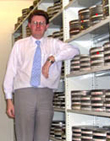|
|
 
|
|
Author
|
Topic: Mylar, Film Clean, and Vitagraph
|
Joe Ritter
Film Handler
Posts: 27
From: Cape May Court House, NJ, USA
Registered: Apr 2001
|
 posted 09-02-2001 11:02 AM
posted 09-02-2001 11:02 AM




Hi All, 1.--Now that all films are made on the new Mylar stock(or I think they are). How long will this stock last? Is it going to be a semi perminent thing like the films of the past, or will it decompose like a milk jug that is left in the sun. It would be funny if the new plastics were designed to self destruct after a year or two. This would eliminate all collectors and would make sure that the big companies could control all copies. 2,-I have recently became aquainted with Film-Clean as used with a Neumade cleaning machine. It is fantastic. I haven`t had to clean my projector yet, although I do look for dirt I just don`t find any. The rolls get dirty and the film runs smoother all the way through. I have had some very old and dirty film and have ran it through the cleaning machine three or four times when rewinding and the rolls come out black but the film, It looks wonderful. Many thanks to Film-Clean. 3.- I have some old nitrate film that says VITAGRAPH on the edge, it is almost pink in color. There is no stickeyness or bad smell to it. Either the film has shrank a lot or the holes were of a different size that modern film. I have soaked it in Film-Renu, dried it off and used Film-Clean on it. This film won`t even fit on a sprocket. Anybody know if it is shrinkage or different hole size and spacing? Don`t worry too much, when I run Nitrate there are two people in the booth and a fire extinguisher within arms reach, and I have fire rollers and enclosed magazines on the projector. Thanks--------Joe Ritter--------
| IP: Logged
|
|
Brad Miller
Administrator

Posts: 17775
From: Plano, TX (36.2 miles NW of Rockwall)
Registered: May 99
|
 posted 09-02-2001 12:49 PM
posted 09-02-2001 12:49 PM




Yes Joe, indeed the humor of watching what could end up being perhaps the only copy of a movie to exist down the road (in a private collection) decompose is hilarious. Studios lose negatives, prints and other pieces of movies and in many cases the only existing copy turned out to be in a collector's hands...thus, the collector's print became the "new negative". That's real good thinking there. We should put you in charge of all film archiving so the entire world can get a good laugh at all of the losses when a studio vault gets flooded.  What is Film-Clean? And since when has Neumade sold a cleaning machine? Are you sure you aren't jumbling up your product names and manufacturers? While there have been differing sprocket sizes over the years, odds are that your Vitagraph print has just shrunk over time and lack of lubrication. (BTW, sorry for the sarcasm in regards to how funny it would be to watch film decompose, but I don't know of any collector who exhibits their films publicly and there have been countless times that a collector was able to supply a studio with a print for a special showing, restoration work or a complete replacement. Collectors are not crooks and accidents at the studio level DO happen.)
| IP: Logged
|
|
|
|
|
|
John Pytlak
Film God

Posts: 9987
From: Rochester, NY 14650-1922
Registered: Jan 2000
|
 posted 09-04-2001 01:59 PM
posted 09-04-2001 01:59 PM





Joe Ritter said: "Now that all films are made on the new Mylar stock(or I think they are). How long will this stock last? Is it going to be a semi perminent thing like the films of the past, or will it decompose like a milk jug that is left in the sun."Polyester film base is very different than the cellulose nitrate or cellulose triacetate film bases that can degrade when stored improperly. Nitrate and triacetate base were made by a chemical reaction between cellulose and acid. Excess humidity and temperature during storage could cause the plastic to break down by a process known as "hydrolysis", releasing acid and moisture that just accelerated the decomposition, especially in a sealed film can. Shrinkage could also occur as residual solvents and plasticizers used in making the base were lost during prolonged storage. Yet, when stored properly (cool, dry, and vented or with molecular sieves to adsorb moisture and acid vapors), there are many nitrate and triacetate films that are in very good condition after many decades of storage. Polyester film base is a thermoplastic, and much more stable chemically and dimensionally. Polyester film base has been in use for almost fifty years. I don't recall any serious incidents of base degradation during storage, and most film archives now make archival copies on polyester base films. BTW, the trade name for Kodak's polyester film base is "ESTAR". Here are links to information about film base and storage:
http://www.kodak.com/US/en/motion/support/h1/base.shtml
http://www.kodak.com/US/en/motion/support/h1/preservation.shtml
http://www.kodak.com/country/US/en/motion/support/technical/vinegar.shtml
http://www.kodak.com/US/en/motion/support/technical/storage1.shtml
http://www.kodak.com/country/US/en/motion/support/technical/molecular.shtml ------------------
John P. Pytlak, Senior Technical Specialist
Worldwide Technical Services, Entertainment Imaging
Eastman Kodak Company
Research Labs, Building 69, Room 7419
Rochester, New York, 14650-1922 USA
Tel: 716-477-5325 Cell: 716-781-4036 Fax: 716-722-7243
E-Mail: john.pytlak@kodak.com
Web site: http://www.kodak.com/go/motion
| IP: Logged
|
|
|
|
|
|
John Pytlak
Film God

Posts: 9987
From: Rochester, NY 14650-1922
Registered: Jan 2000
|
 posted 09-07-2001 11:50 AM
posted 09-07-2001 11:50 AM





Leo asked: "A question for John P - if polyester has been in use for over fifty years, why did it only become widespread for motion picture film base in the early '90s?".Polyester prints offered many advantages and were widely used in applications like special venue (IMAX, theme parks), airline films, educational/industrial films, etc. The National Association of Theatre Owners technical advisory committee issued a statement requesting the conversion to polyester in the early 1990's. I gave a technical presentation at the ShoWest Convention in March 1994 indicating several concerns (static, projector abrasion, proper use of tension-sensing failsafes) that needed to be addressed before the widespread introduction of polyester prints for general theatrical use. Kodak began working on the development of VISION Color Print film, which has addressed the issues of static and projector abrasion. ------------------
John P. Pytlak, Senior Technical Specialist
Worldwide Technical Services, Entertainment Imaging
Eastman Kodak Company
Research Labs, Building 69, Room 7419
Rochester, New York, 14650-1922 USA
Tel: 716-477-5325 Cell: 716-781-4036 Fax: 716-722-7243
E-Mail: john.pytlak@kodak.com
Web site: http://www.kodak.com/go/motion
| IP: Logged
|
|
|
|
|
|
|
|
|
|
All times are Central (GMT -6:00)
|
|
Powered by Infopop Corporation
UBB.classicTM
6.3.1.2
The Film-Tech Forums are designed for various members related to the cinema industry to express their opinions, viewpoints and testimonials on various products, services and events based upon speculation, personal knowledge and factual information through use, therefore all views represented here allow no liability upon the publishers of this web site and the owners of said views assume no liability for any ill will resulting from these postings. The posts made here are for educational as well as entertainment purposes and as such anyone viewing this portion of the website must accept these views as statements of the author of that opinion
and agrees to release the authors from any and all liability.
|

 Home
Home
 Products
Products
 Store
Store
 Forum
Forum
 Warehouse
Warehouse
 Contact Us
Contact Us




 Printer-friendly view of this topic
Printer-friendly view of this topic
















